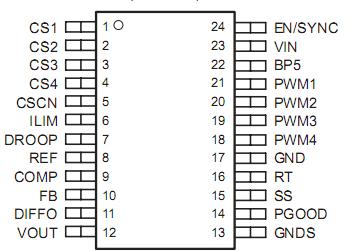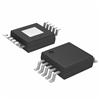Features: Two-, Three-, or Four-Phase Operation
5-V to 15-V Operating Range
Programmable Switching Frequency Up to 1-MHz/Phase
Current Mode Control With Forced Current Sharing(1)
1% Internal 0.7-V Reference
Resistive Divider Set Output Voltage
True Remote Sensing Differential Amplifier
Resistive or DCR Current Sensing
Current Sense Fault Protection
Programmable Load Line
Compatible with UCC37222 Predictive Gate Drive Technology Drivers
24-Pin Space-Saving TSSOP Package
TPS40090: Binary Output
TPS40091: Tri−State OutputApplicationInternet Servers
Network Equipment
Telecommunications Equipment
DC Power Distributed Systems Pinout Specifications
Specifications Description
DescriptionThe TPS40091 are two-, three-, or four-phase programmable synchronous buck controllers, optimized for low-voltage, high-current applications powered by a 5-V to 15-V distributed supply. A multi-phase converter offers several advantages over a single power stage of TPS40091 including lower current ripple on the input and output capacitors, faster transient response to load steps, improved power handling capabilities, and higher system efficiency.
Each phase of TPS40091 can be operated at a switching frequency up to 1-MHz, resulting in an effective ripple frequency of up to 4-MHz at the input and the output in a four-phase application. A two phase design operates 180 degrees out-of- phase, a three-phase design operates 120 degrees out of phase, and a four-phase design operates 90 degrees out of phase as shown in Figure 1.
The number of phases of TPS40091 is programmed by con−necting the de-activated phase PWM output to the output of the internal 5-V LDO. In two-phase operation the even phase outputs should be de-activated.
The TPS40091 uses fixed frequency, peak current mode control with forced phase current balancing. When compared to voltage mode control, current mode results in a simplified feedback network and reduced input line sensitivity. Phase current is sensed by using either current sense resistors installed in series with output inductors or, for improved efficiency, by using the DCR (direct current resistance) of the filter inductors. The latter method of TPS40091 involves generation of a current proportional signal with an R-C circuit (shown in Figure 10.
The R-C values of TPS40091 are selected by matching the time constants of the R-C circuit and the inductor; R-C = L/DCR. With either current sense method, the current signal is amplified and superimposed on the amplified voltage error signal to provide current mode PWM control.
An output voltage droop of TPS40091 can be programmed to improve the transient window and reduce size of the output filter. Other features include a single voltage operation, a true differential sense amplifier, a programmable current limit, soft-start and a power good indicator.

 TPS40091 Data Sheet
TPS40091 Data Sheet









